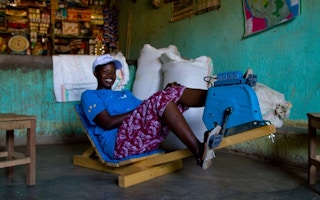ABU DHABI – In recent years, an increasingly loud chorus of environmentalists, civil-society actors, and international institutions have been demanding that conventional “brown” economic development, which depends on fossil fuels, be replaced by a lower-carbon “green” growth model. But there is a third, more competitive option: a “blue” economy driven by business-level innovation, rather than top-down policies.
The fact is that most environmentally friendly technologies demand significant upfront investment, meaning that “going green” remains a privilege reserved for the few countries that can afford it. After all, governments’ capacity to provide subsidies is limited, and wealthy countries cannot be expected to bear the costs of the uptake of sustainable technologies worldwide. Thus, as the United Nations recently confirmed, more than a billion people worldwide still lack access to reliable, clean, and affordable energy.
The blue economy – a concept developed by the Belgian economist Gunter Pauli – is powered less by investment and more by innovation, with a focus on creating jobs, building social capital, and generating multiple cash flows by stimulating entrepreneurship and the development of new business models. The blue economy is centered on the idea that companies should use all available resources and increase efficiency to develop a portfolio of related businesses that benefit both them and society.
Consider the Swedish company Solarus AB, whose innovative business model – manufacturing solar panels out of carbon fibers discarded by the aerospace industry – has enabled it to offer competitively priced solar technologies, without support from government subsidies. The fact that solar technologies can be produced locally from recycled materials, Pauli argues, means that governments should not provide solar-related subsidies and bailouts – the costs of which eventually land on taxpayers.
The blue economy would also help to resolve the intermittency problem inherent in solar- or wind-power systems. Even after the needed technologies are deployed widely, additional investment in power storage or a back-up energy would be needed. Given that an abundant hydropower backup supply would not be an option everywhere, businesses would have to find ways to employ the energy and resources available locally.
It is not difficult to discern the potential benefits – for businesses and communities alike – of matching a set of seemingly disparate problems with the efficient use of locally available resources. Companies simply must be willing to develop bold and creative new business models that change the rules of the game.
“
A report in 2012 by the Ellen MacArthur Foundation estimated that the circular economy concept could save the European Union alone $380 billion annually in materials for medium-lifespan consumer durables such as cars, furniture, and household electric appliances
For example, the production of coffee – a coffee company’s only revenue stream – typically requires only 0.2% of the coffee plant. Instead of discarding the remaining 99.8%, the company could, say, grow mushrooms and, with the waste from that process, create a protein-rich livestock feed, which could also be converted into a natural source of energy.
Nuru Energy put this kind of innovation into practice, developing a human-powered cycle that provides clean power across Africa using recyclable plastic parts and locally available materials. Likewise, in the United Kingdom, Cyndi Rhoades launched “Worn Again,” which produces fashionable products from unusual recycled materials like scrap leather from car seats, parachutes, and prison blankets.
Of course, the idea of reusing materials within continuous closed loops to extract their maximum value is not a new one. But it has recently been revived, with the emergence of the “circular economy” concept, which calls for the continual re-exploitation of resources through the reuse and refurbishment of products, components, and materials.
A report in 2012 by the Ellen MacArthur Foundation estimated that the circular economy concept could save the European Union alone $380 billion annually in materials for medium-lifespan consumer durables such as cars, furniture, and household electric appliances. The second and third volumes of the report estimated that the world could save as much as $700 billion each year on single-use consumer goods like packaged food and beverages. Incorporating such loops into the broader framework of the blue economy would bring even greater benefits.
As the world heads toward catastrophic levels of resource depletion and environmental degradation, calls for a new economic model – whether green, blue, circular, or something else – will only grow louder. And many people are willing to put their money where their mouth is.
The proliferation of information technology and social media means that it is easier than ever for entrepreneurs to tap into a large pool of finance – not to mention contacts and expertise – from small investors. Of the roughly 500 crowdfunding platforms that now exist, several specifically target clean technologies. Last May, Eureeca.com took the crowdfunding concept further than ever, creating the first truly global crowd-investing marketplace that offers equity in funded companies.
If used wisely, such platforms could take up the slack created by governments’ fiscal constraints to facilitate the entrepreneurial innovations needed to build the blue economy. Other increasingly prominent trends – such as collaborative consumption, pay per use, and sharing and leasing models – could offer similarly powerful impetus to these efforts.
Given the impracticality – financial and otherwise – of relying on top-down solutions, the creation of a cleaner economy should rely on visionary entrepreneurs who can transform challenges into opportunities. Sustainability begins at the grass roots.
Yasser Al-Saleh is a senior research fellow at INSEAD Innovation and Policy Initiative. He is the author of The Prospects for Sustainable Energy Innovation within Oil-rich Gulf Cooperation Council. This post originally appeared in Project Syndicate.

















